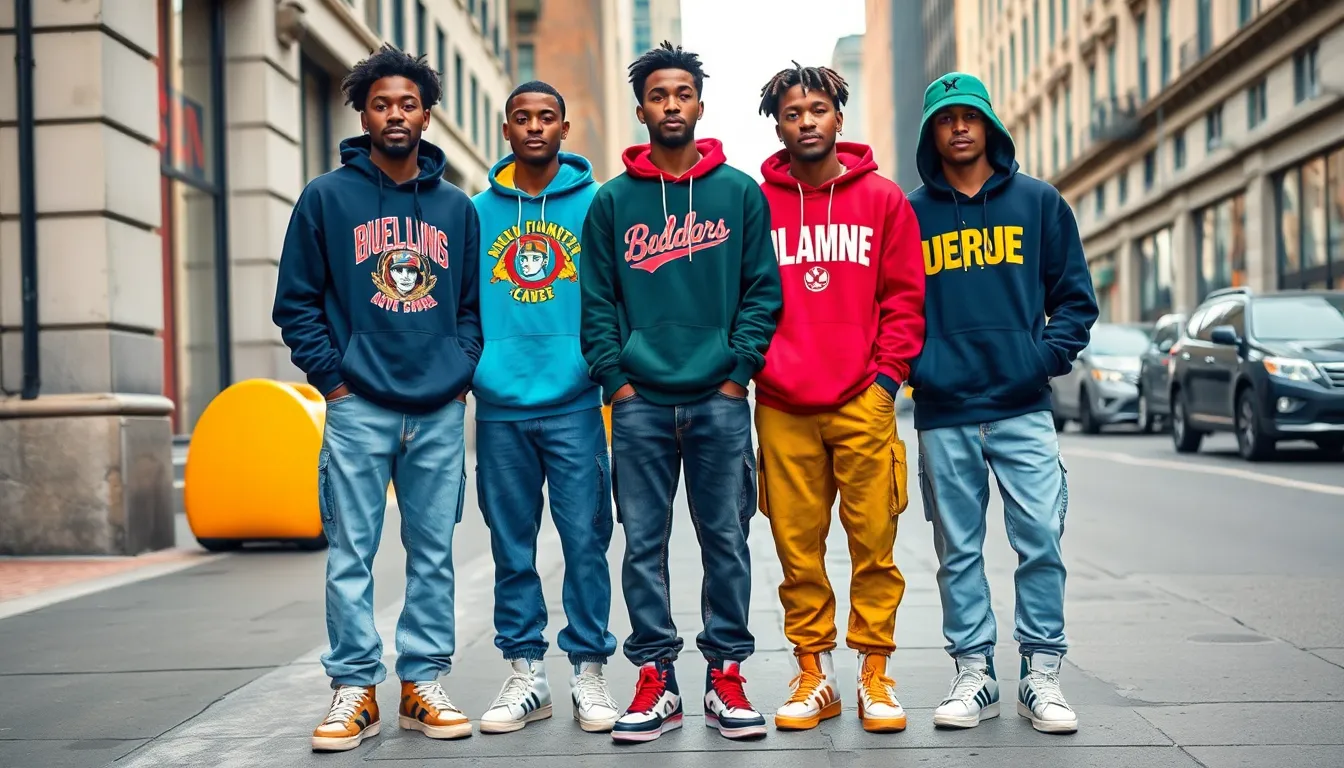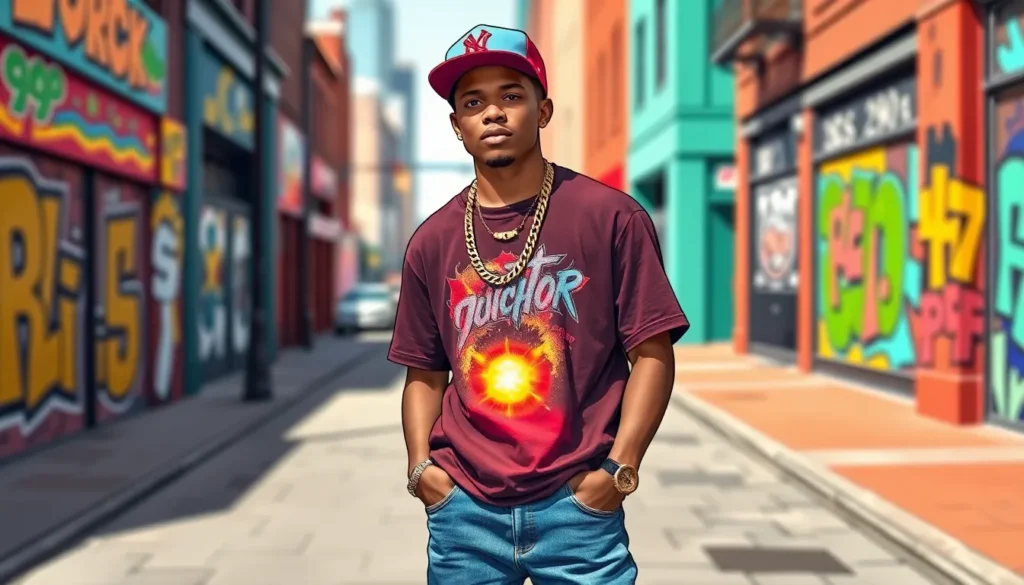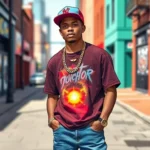Table of Contents
ToggleImagine stepping into a time machine and landing in the vibrant streets of the 90s, where baggy jeans, oversized tees, and fresh kicks ruled the scene. Streetwear male 90s hip hop fashion wasn’t just a trend; it was a lifestyle that spoke volumes without saying a word. This era birthed an iconic style that blended comfort with bold expression, capturing the essence of a generation that dared to be different.
From the unmistakable swagger of artists like Tupac and Biggie to the colorful patterns and logos that defined the streets, this fashion movement has left a lasting legacy. It’s not just about looking good; it’s about embracing a culture that celebrates individuality. So grab your snapback and get ready to dive into the world where style meets attitude, and discover how the 90s hip hop scene continues to influence fashion today.
Overview Of Streetwear Male 90s Hip Hop Fashion
Streetwear male 90s hip hop fashion stands as a defining style that shaped urban culture. Characterized by oversized clothing, vibrant colors, and bold logos, this fashion genre emphasizes individuality. Influential artists like Tupac Shakur and The Notorious B.I.G. popularized aesthetics that merged comfort with self-expression. Baggy jeans and graphic tees became staples in wardrobes, reflecting a lifestyle that valued authenticity.
Athletic wear also played a significant role in this fashion movement. Brands such as Nike, Adidas, and Fila produced iconic pieces that complemented the streetwear aesthetic. Track suits and sneakers, often worn with matching accessories, made statements on and off the stage. Streetwear further embraced bold patterns and distinctive materials, enhancing its visual appeal.
Accessories contributed meaningfully to the style during this era. Snapback caps, chunky jewelry, and crossbody bags served functional and fashionable purposes. Each element worked together to create a cohesive look that resonated with youth culture, consciously or subconsciously. The influence of skate culture also intertwined with hip hop fashion, introducing unique graphics and styles.
Cultural significance marked this fashion’s evolution beyond mere clothing. It acted as a canvas for social issues, allowing artists to convey messages through their outfits. Festivals, concerts, and urban events showcased this array of styles, turning streets into runways. The authenticity of streetwear male 90s hip hop fashion remains relevant, inspiring modern interpretations that resonate with new generations.
Key Elements Of 90s Hip Hop Fashion

90s hip hop fashion emphasizes self-expression through bold and distinct styles. Key elements contribute to this iconic look, showcasing the cultural significance and influence of the era.
Baggy Clothing
Baggy clothing defined the 90s hip hop aesthetic. Oversized pants, shorts, and jackets created a relaxed, comfortable fit. Artists like Notorious B.I.G. popularized these loose silhouettes, prioritizing freedom of movement. Comfort became a vital aspect for many fans. Common choices included cargo pants and basketball shorts, often paired with oversized shirts. Layering styles, such as hoodies under jackets, added dimension to outfits. Fashion enthusiasts embraced the trend, making baggy clothing synonymous with the hip hop movement.
Graphic Tees
Graphic tees served as a canvas for self-expression in the 90s. Bold colors and eye-catching designs captured attention on the streets. Many shirts featured logos from popular music groups, brands, or impactful graphics reflecting socio-political messages. Artists used this medium to connect with their fan base. Styles varied widely, showcasing everything from comedic images to thought-provoking statements. The influence of skate culture introduced unique designs, enhancing the creativity of graphic tees. Wearing these shirts became a way to showcase individuality and passion for hip hop culture.
Sneakers
Sneakers revolutionized footwear in the 90s hip hop scene. Signature styles from brands like Nike and Adidas gained tremendous popularity. High-top models provided both support and style, mirroring the influence of basketball culture. Common choices included models like the Air Jordan and Adidas Superstar. The sneaker culture created an eagerness to collect limited editions, turning footwear into a statement. Sneakers complemented streetwear outfits, enhancing the overall vibe. Comfort and style coexisted, establishing sneakers as essential elements of 90s hip hop fashion.
Influential Icons And Trends
Cultural icons significantly shaped the landscape of 90s hip hop fashion. Artists like Tupac Shakur and The Notorious B.I.G. used their style as a form of self-expression. Their bold outfits and unique perspectives resonated with fans, influencing a generation. Similarly, figures like A Tribe Called Quest and Nas contributed their distinctive flair to the scene. The use of oversized clothing, vibrant colors, and flashy accessories became synonymous with their identities.
Major brands played a vital role in defining 90s hip hop fashion. Nike and Adidas provided the athletic wear that complemented this lifestyle. Track suits and branded sneakers became essential style statements. Fubu and Karl Kani also made waves with their urban appeal, appealing to young audiences. Their designs embraced bold logos and unique graphics, solidifying a connection to hip hop culture. The collaboration between artists and brands further propelled streetwear into mainstream fashion, solidifying its lasting impact.
The Evolution Of Streetwear
Streetwear emerged in the 90s as a distinct fashion movement intertwined with hip hop culture. Influential artists like Tupac and Biggie introduced styles that emphasized boldness and individuality. Key elements included oversized clothing, vibrant colors, and prominent logos, defining a unique aesthetic that resonated with youth.
Athletic wear became a staple, with brands such as Nike and Adidas releasing iconic track suits and sneakers. Baggy clothing prioritized comfort, allowing for free movement on stage and in everyday life. Graphic tees served not only as fashion statements but also as platforms for socio-political expression, often featuring striking designs.
Influencers shaped trends within this fashion evolution. A Tribe Called Quest and Nas infused personal style into their public personas, impacting how fans perceived fashion in hip hop. Brands like Fubu and Karl Kani embraced bold graphics and logos, creating a visual language that connected deeply with the audience.
Collaborations between artists and brands became common, propelling streetwear into mainstream fashion. Events such as urban festivals showcased these styles, turning streets into vibrant runways. Accessories like snapback caps and chunky jewelry enhanced personal style, adding layers of self-expression.
Cultural significance remains enduring. The fashion of the 90s continues to inspire contemporary streetwear, emphasizing authenticity and individuality. Current designs often reflect nostalgia while adapting to modern aesthetics. As a result, the essence of 90s hip hop streetwear remains relevant, influencing new generations and perpetuating the celebration of self-expression.
How To Incorporate 90s Hip Hop Style Today
Embrace oversized clothing by selecting baggy jeans or wide-legged trousers, which provide comfort and nod to the iconic fashion of the 90s. Incorporate graphic tees featuring bold designs or cultural references that reflect individuality and self-expression. Invest in vintage sports jackets or track suits from brands like Nike or Adidas, as they capture the essence of streetwear while ensuring a stylish look.
Choose sneakers that evoke nostalgia, opting for models such as Air Jordans or classic Adidas Superstars. These footwear options not only enhance outfits but also serve as a tribute to hip hop’s footwear revolution in the 90s. Accessorize with snapback caps or bucket hats, adding layers of style and authenticity reminiscent of popular hip hop artists.
Layering different textures and patterns makes outfits visually engaging. Mix plaid flannel shirts with bright patterned shirts or hoodies—this combination reflects the eclectic style that characterized the era. Chunky jewelry, such as gold chains or statement rings, can elevate the look and enhance its streetwear vibe.
Utilizing earthy tones along with vibrant colors creates a balanced aesthetic. Earthy tones ground outfits, while striking colors remind of the vibrancy found in 90s hip hop fashion. Incorporate elements like bandanas or statement belts to further connect with the genre’s distinctive style.
Referencing influential figures like Tupac or The Notorious B.I.G. can inspire outfit choices, showcasing a sense of appreciation for the artists who shaped this fashion movement. By curating ensembles that pay homage to 90s hip hop, one expresses a deep connection to the culture and its rich, diverse history.
The legacy of 90s hip hop streetwear continues to resonate in today’s fashion landscape. Its blend of comfort and bold expression laid the groundwork for modern styles that prioritize individuality. As new generations embrace this vibrant aesthetic, they also honor the cultural significance behind it.
Incorporating elements like oversized clothing and iconic sneakers allows today’s fashion enthusiasts to connect with a rich history. This enduring influence proves that 90s hip hop fashion is more than just a trend; it’s a celebration of self-expression and authenticity that remains relevant in contemporary wardrobes. By drawing inspiration from the past, individuals can create unique looks that reflect their personal style while paying homage to an iconic era.





